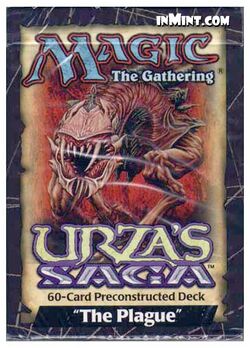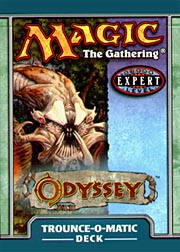Theme deck

Theme decks are preconstructed decks which were aimed at new and casual players. They originally were released with every expansion from Tempest in 1997 through to Eventide in 2007, Starter sets from Portal Second Age and Core Sets from Seventh Edition to Tenth Edition. They were reintroduced for Lorwyn Eclipsed in 2026.[1]
Description
In general, theme decks are decks that possess a unifying idea, image, or motif, repeated or developed throughout.[2] A theme deck may be based on certain subtypes (for example, a typal theme deck focused on Wizards) or other things, such as mechanics (for example, a theme deck focused on dredge, flashback, and threshold). Casual variat may be based on flavor (for example, a theme deck focused on cards referring to Nicol Bolas and featuring cards with draconic creatures in their illustrations), or artists (for example, a theme deck focused on cards illustrated by John Avon).
Original run
The Rath Cycle
Preconstructed theme decks were first introduced for the Tempest expansion set and contained 60 cards. The rarity distribution echoed that of the random Starter decks of the time: three rares, nine uncommons with the remainder commons and basic lands. There were four of these decks, all of which were bi-colored.
Stronghold, the second set of the block, would introduce the first mono-colored theme deck: Migraine. The final set, Exodus, is notable for not having any Theme deck containing Green. While there wasn't any strict requirement for color balance with theme decks, as there was with the later Intro Packs, it was still uncommon not to have all colors represented in at least one deck from a set.
Theme decks from The Rath Cycle are considered to be among the best and most powerful Preconstructed decks of their type.[3][4]. In particular, Magic columnists like Abe Sargent and Jay Kirkman have named The Sparkler, a near-creatureless "Counterburn" deck, as the best Theme deck ever released[5][6]. Many decks included powerful rares like Aluren or Ensnaring Bridge as well as full playsets of cards like Counterspell or Kindle. Additionally, strategies such as discard, land destruction and Draw-Go control were seldomly revisited in future sets; never with a comparable power level.
The Artifact Cycle

From Urza's Saga onwards, theme decks contained 2 rares and 13 uncommons. It was the first expansion set to have a three-color theme deck: Tombstone.
The Urza's Legacy deck Radiant's Revenge is notable as the only theme deck to have both rares be artifacts. With the black/green Fiendish Nature from Urza's Destiny there was finally one theme deck for each of the ten two-color combinations.
While Urza's block is considered one of the most broken blocks of all time, the power level of its theme decks was pared back from those of Tempest. There were fewer playsets of strong staple effects and decks were generally more creature focused with greater variance in their gameplay. A notable exception, however, was the white/black The Plague. This deck is another which is highly regarded[3][4][7] and is built around four copies of Pestilence and Protection from Black effects. It is capped off by having the powerful enchantments Pariah and Worship as its two rares.
The Masquerades Cycle
The Masques block theme decks would follow the design guidelines established with Urza's Saga. However, as a consequence of the lower power level of Masques Block the decks themselves ended up weaker on average than those of Saga and Invasion blocks.
Nemesis' Eruption was the last red/white theme deck to be released for six-and-a-half years until Charge of the Boros in Ravnica: City of Guilds.
Invasion Block
As multicolor was the theme of the Invasion block, naturally Invasion was the first expansion set to have a five-color theme deck: Spectrum. Successive sets Planeshift and Apocalypse would also each release a five-color theme deck too, as well as three three-color decks between them.
Odyssey Block

The most notable aspect of the Odyssey block theme decks is that Torment, "the black set", had all four decks contain the colour black. Judgment, the final set of the block, balanced this by not having any black decks.
Trounce-O-Matic from Odyssey is another infamous theme deck[3][7]. It is a blue and green deck built around the Threshold mechanic and can be considered a precursor to the UG Madness deck which found success in multiple competitive formats.
Onslaught block
Onslaught theme decks introduced a new design on their cardboard box that quickly showed the colors used to build the deck. As a typal block, most of its theme decks had a typal strategy.
Goblin Mob, from Scourge, is notable as being the first monored theme deck in an expert level expansion. Red was the final color to receive a dedicated deck.
Mirrodin Block
The theme decks of Mirrodin block all had a strong focus on artifacts, like the block itself.
The decks Bait and Bludgeon from Mirrodin and Transference from Darksteel are notable for containing a lot of cards used in the dominate Affinity decks of Mirrodin-era Standard. Transference also included a pair of Skullclamp which would end up banned in multiple formats. The Fifth Dawn precon Nuts and Bolts also included a single copy of the card.
Kamigawa Block

In a similar way to Mercadian Masques, the theme decks of Kamigawa block were affected by Wizards of the Coast's reaction to the mistakes of Mirrodin block. The decks were all underpowered in comparison to other sets, with the decks of Saviors of Kamigawa being particularly egregious.[7].
Rats' Nest from Betrayers of Kamigawa included Umezawa's Jitte as one of its two rares. Due to the power of that Equipment it was selling on the secondary market for more than the complete Rats' Nest deck cost. This led to supply issues with players buying up multiple copies of the theme deck specifically for the Jittes.
Ravnica Block
Ravnica block had ten theme decks, one for each of the Guilds. This meant that Guildpact and Dissension, which featured three guilds each, only had three theme decks. These sets were the first expansions to deviate from the four decks per set model.
Coldsnap
Coldsnap, which was designed as the belated final set of the Ice Age block, returned to having four theme decks. In addition to the new cards from Coldsnap the decks also reprinted cards from Ice Age and Alliances in the Eighth Edition card frame.
Time Spiral Block
Time Spiral block had four decks per expansion. Its decks tended to get pretty positive reviews[3] and the block could be considered a high water mark in terms of preconstructed deck design.
Lorwyn and Shadowmoor Blocks
The twin blocks of Lorwyn and Shadowmoor had nineteen theme decks between them. Each expansion had five decks, except for Morningtide which only had four.
Lorwyn and Morningtide's theme decks had both had typal strategies, while Shadowmoor and Eventide focused on interactions around Hybrid mana. The second two sets had decks for each Allied and Enemy color combination respectively. They consequently ended up previewing the more structured color distribution of the Intro packs which would replace theme decks from Shards of Alara.
Starter-level sets
Portal did not contain theme decks, but Portal Second Age and Portal Three Kingdoms contained five and three decks respectively. Each of these decks contained three rares. Starter 1999 contained five theme decks, each with two rares. All of them had 40 cards and were monocolored.
Core sets
Theme decks for core sets were introduced with Seventh Edition, after the discontinuation of the Starter-level sets. There were five monocolored decks which contained two rares and seven uncommons with a total of 40 cards.
Magic Online
Mirage block
Mirage block didn't have physical theme decks, but when Mirage was released on Magic Online in 2005 four decks were released for it. Uniquely, three of the four decks were designed outside Wizards R&D:
- The content of Burning Sky was voted for in a series of articles on dailymtg.com[8][9].
- Jungle Jam was designed by Markus Pettersson, the winner of the "Design a Mirage Theme Deck" tournament.[10][11]
- Building on a Budget columnist Jay Moldenhauer-Salazar designed Night Terrors.[12][13]
- The final deck, Ride Like the Wind, was designed in-house to complement the other three.
Masters Edition II
Masters Edition II was the only set of the MTGO Masters series to have theme decks. There were four monocolored decks which used cards from both Masters Edition and Masters Edition II, which predominantly consisted of cards printed before Mirage which weren't already available on the client.
Reintroduction
In 2026, new Theme Decks were released alongside Lorwyn Eclipsed. These are 60-card, Standard-legal decks are designed to introduce players to Constructed formats, and to play well against each other and against future Theme Decks that will be released with in-universe Standard sets. The flavor of the decks is not specific to set-specific;[14] they include cards from across Standard.[1]
References
- ↑ a b Mike Turian and Jubilee Finnegan (September 26, 2025). "Collecting Lorwyn Eclipsed". magicthegathering.com. Wizards of the Coast.
- ↑ Marcus Shirley (March 16, 2009). "Myth, Theme, and Wonder". magicthegathering.com. Wizards of the Coast. Archived from the original on 2020-09-23.
- ↑ a b c d Abe Sargent (August 30, 2011). "CasualNation #48 – Top Ten Theme Decks of All Time (website)". Star City Games. Retrieved on March 10, 2025.
- ↑ a b Beats and Skies (November 28, 2024). "The definitive Premodern-era Theme Deck Top 10. (website)". Retrieved on March 10, 2025.
- ↑ Abe Sargent (August 8, 2023). "Why the Sparkler is the best Precon Ever Made! (website)". CoolStuffInc. Retrieved on March 10, 2025.
- ↑ Jay Kirkman (November 9, 2016). "History of Izzet Theme Decks (website)". CoolStuffInc. Retrieved on March 10, 2025.
- ↑ a b c TriceratoppingMTG (October 22, 2020). "M:tG Precon Decon - Season 1 Finale and Top/Bottom 5 (video)". YouTube. Retrieved on March 10, 2025.
- ↑ Frank Gilson (October 06, 2005). "You Make the Mirage Theme Deck (website)". Wizards of the Coast. Archived from the original on February 9, 2010. Retrieved on March 11, 2025.
- ↑ Burning Sky (website). Wizards of the Coast (October 06, 2005). Archived from the original on November 3, 2007. Retrieved on March 11, 2025.
- ↑ "Design a Mirage™ Theme Deck" Tournament (website). Wizards of the Coast (August 4, 2005). Archived from the original on September 06, 2007. Retrieved on March 11, 2025.
- ↑ Bennie Smith (September 29, 2005). "Whoever Won That Mirage Precon Contest? (website)". Wizards of the Coast. Archived from the original on November 03, 2007. Retrieved on March 11, 2025.
- ↑ Jay Moldenhauer-Salazar (October 3, 2005). "Interlude: My Mirage Precon, Part 1 (website)". Wizards of the Coast. Archived from the original on February 22, 2007. Retrieved on March 11, 2025.
- ↑ Jay Moldenhauer-Salazar (October 10, 2005). "Interlude: My Mirage Precon, Part 1 (website)". Wizards of the Coast. Archived from the original on February 23, 2007. Retrieved on March 11, 2025.
- ↑ The Preview Panel at MagicCon: Atlanta (Video). Magic: The Gathering. YouTube (September 26, 2025).